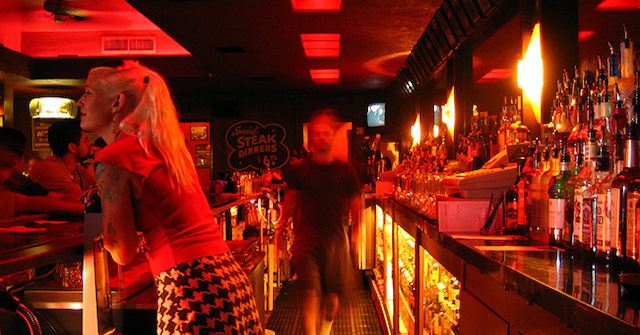Getting hit on by customers is a fact of life for anyone who works behind a bar. Knowing how to deal with a come-on is as much a part of the job as knowing how to make a Martini. Every bar employee has stories about guests behaving badly. But that bad behavior often crosses the line from banter to harassment.
Unfortunately, stories like these from a bartending thread on Reddit are common:
“He would circle my bar and just stare at me. I would tell him to leave … and he wouldn’t go. I thought ignoring him would be fine. I left for a week in between and when I came back he was still there.”
“Someone [waited] on the patio for 45 minutes till I came out at 3:30 then tried to demand to walk me home …”
“A customer told me he was ‘going to have sex with me whether I liked it or not.'”
A study by restaurant industry group ROC said that 78 percent of servers and bartenders surveyed were harassed by customers. Nearly two-thirds said they ignore sexually harassing behaviors, often for fear of looking harsh in front of other customers or losing tips.
“There’s that fine line when it’s your income so you are trying to be nice,” says Penni Marler, who has worked as a server and bartender in several Tennessee bars. “If they see you being defensive or forceful to a customer, it turns the others off. But there’s that line they cross where you have to take back control.”
Appearing tough is part of a bartender’s armor against harassment, so it can be difficult to admit there’s a problem. Marler stresses how she hasn’t felt unsafe, because she’s extremely cautious and “ready to kick anyone’s butt.” But she also realizes that being so vigilant may be a sign she actually has felt unsafe.
“Let’s put it this way, I’m cautious enough that I carry a pistol with me,” Marler says.
Whether it’s innocent flirting, full-on harassment or something in between, bartenders are likely to spend time at work dealing with inappropriate behavior. Working behind the bar means your relationship status, clothing choices and appearance are all up for scrutiny and comment by customers.
“Jane,” a 24-year-old bartender at an Irish pub near San Francisco, asked to remain anonymous. She says that on a Friday or Saturday night behind the bar, she gets hit on by customers “15 to 20 times.” There are few other industries where a typical shift means more than a dozen people proposition you while you try to work.
“Customers ask if I’m single all the time, and a lot act like I am no matter what I say,” she says. “Part of my job is to get hit on.”
Although the study found that women in the industry experience harassment twice as much as their male counterparts, men are also frequent targets of sexually aggressive behavior.
“I once had to buy a hotel room for a guest because she refused to get into a cab and wouldn’t say where she lived,” says Robert Cimmino, who has been a bartender for the last seven years at fine dining restaurants and craft bars throughout Texas. “She was doing anything to get me to take her to my place. I lived two blocks away. Such a disaster.”
One man on a bartending forum said customers have spanked him, grabbed his genitals and put their hands inside his shirt. He felt violated — but he also felt like he was expected to shake it off and feel lucky that women were giving him sexual attention.
Some bartenders are speaking out publicly about harassment. After being groped by a customer, New York bartender Laura Ramadei wrote a Facebook post that went viral. In addition to recounting the incident, she shared a specific kind of anger and frustration that many bartenders identified with.
“I can’t tell you how many times people have treated me horribly and I’ve memorized or photographed the names from their credit cards, fantasizing about Internet revenge.” Ramadei wrote. “But every time I’ve been tempted in the past (even after verbal attacks, physical affronts or sexual harassment) I’ve stopped myself and let it go.”
Managers and owners can be wary of creating a lot of rules or “ruining” a bar’s laid-back atmosphere. But the responsibility for communicating what sexual harassment is, what steps to take when it happens and how management will deal with it falls on the employer, not the employee. Every bar, no matter the size, needs to communicate clearly that harassment of its workers won’t be tolerated and will be handled appropriately. A written policy isn’t overkill; it’s the best way to show employees you’re serious about their safety.
When possible, another bartender should take over when a customer makes someone on staff feel uncomfortable. Managers need to encourage this kind of teamwork and should make it clear that someone who needs help isn’t thin-skinned. Cimmino says he’s noticed that male bartenders are quicker to call out bad behavior, likely because of the stigma against women “complaining” in a male-dominated industry.
“But once [female co-workers] see that we’re standing behind them and never question them when there’s a concern, they are more comfortable saying something,” Cimmino says.
Not every bar can or should have bouncers. But managers need to give bartenders someone to turn to when things get out of control. If someone works alone and feels threatened, they need to know they can call the owner, manager or even the police without hurting their standing on the job.
Many problems come from customers who have been over-served. Avoiding that is everyone’s job. But having a clear policy about how and when to communicate about intoxicated or unruly customers is the owner or manager’s job.
After its study of the industry, ROC concluded that the “complaint-based” model of dealing with sexual harassment has failed because many workers are “afraid of retaliation, uncertain their claims will be taken seriously or unaware of their rights.” A harassment policy and open communication are a start. But actions speak louder than words.
Black Acre Brewing Co. co-owner Jordan Gleason wrote a detailed Facebook post about how he banned a customer from the Indianapolis pub for repeatedly harassing female bartenders. He urged the industry to take harassment seriously.
“Don’t just laugh it off or ignore it. We need to listen when our sisters talk about this, and not just blame it on some bad apples. Not just say “not all dudes do that” or “well no one I know would ever do that,” Gleason wrote. “This is an endemic cultural problem … We need to open our eyes and fight it everywhere we see it, because the only way this thing gets better is to start calling it out for what it is.”





